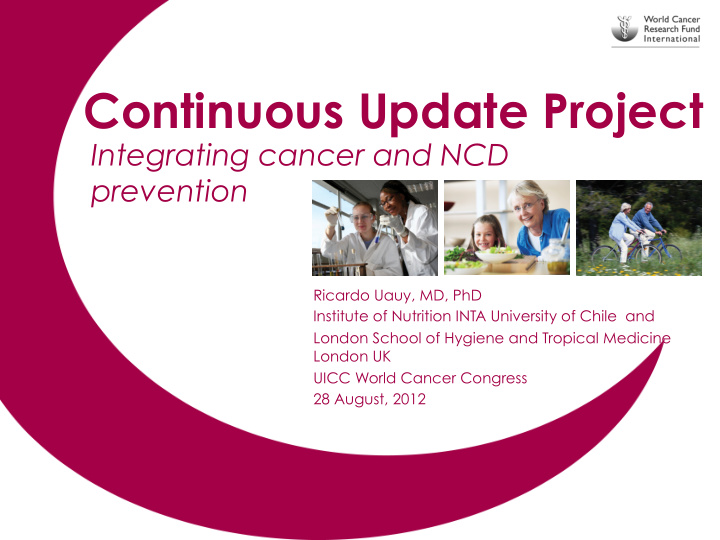



Continuous Update Project Integrating cancer and NCD prevention Ricardo Uauy, MD, PhD Institute of Nutrition INTA University of Chile and London School of Hygiene and Tropical Medicine London UK UICC World Cancer Congress 28 August, 2012
Life expectancy at birth (2008) 80-85 75-80 70-75 65-70 60-65 55-60 < 55 NA
Demographic Transition 1890-2030 (% pop > 65 yrs old) % aged > 65
Global population is increasing and growing older leading to increasing cancer rates
Deaths attributable to 16 leading risk factors: all countries, 2008 Blood pressure Tobacco Use High mortality – Developing Cholesterol Underweight Low mortality Unsafe sex – Developing Fruit & vegetable High body mass Index Developed countries Physical inactivity Alcohol Unsafe water, hygiene Indoor smoke/fuels Iron deficiency Urban air pollution Zinc deficiency Vitamin A deficiency Unsafe health/injections 1000 2000 3000 4000 5000 6000 7000 8000 0 Deaths (000) Adapted from World Health Report 2008
Deaths in low and middle-income countries 60 million 50 million Injuries ¡ NCDs ¡ 40 million over ¡age ¡70 ¡ 14 million premature deaths 30 million NCDs ¡below ¡age ¡70 ¡ due to NCDs (preventable) ¡ (CVDs and 20 million Communicable ¡ Cancer) diseases, ¡maternal, ¡ 10 million perinatal ¡and ¡ nutri3onal ¡condi3ons ¡ 0 Total number of deaths in LMICs (millions) Source: ¡WHO, ¡2008 ¡ h1p://www.who.int/healthinfo/global_burden_disease/2004_report_update/en/index.html ¡
Projected deaths averted by income group if global goal for 2006-15 is achieved WHO Chronic Disease report 2005 36 Million lives can be saved Goal: 2% reduction in NCDs death rates per year, over next 10 yrs
Causes of Chronic Diseases WHO Chronic Disease report 2005
EXPERT REPORT PROCESS Key features q Rigorous methodology q Systematic reviews q Review of evidence separate from judgement q Panel of international experts q Predetermined criteria for judgements q Flexibility
2007 WCRF/AICR Report Recommendations • Based on evidence relating to cancer • Compared to recommendations for other chronic disease • Recommendations are consistent with prevention of obesity, diabetes, CHD, and nutritional deficiencies
Recommendations from the 2007 WCRF/ AICR Expert Report The Panel emphasises the importance of not smoking and of avoiding exposure to tobacco smoke
Germany: The Melander family of Bargteheide Food expenditure for one week US $500
Ecuador: The Ayme family of Tingo Food expenditure for one week US $31.55
Chad: The Aboubakar family of Breidjing Camp Food expenditure for one week US $1.23
Diets of Rural Chinese Children 1991-2006
Continuous Update Project q Keep evidence, conclusions and recommendations updated into the future q Same principles and rigorous methodology
Pre-natal Post-natal Pre Early Pregnancy Pubertal BMI maturation Early Adiposity rebound Maternal Glucose Weight Insulin gain with Central limited Obesity length Metabolic gain Fetal syndrome growth restriction Placental Hormonal Fetal blood responses flow High BMI Fetal Macrosomia Hormonal responses Obesity Epigenetic changes
Conclusions. • There is an association between thinness in infancy and the presence of impaired glucose tolerance or diabetes in young adulthood. • Crossing into higher categories of body-mass index after the age of two years is also associated with these disorders. Bhargava SK et al NEJM 350: 865-875 2004
IMPACT OF OFFSPRING SIZE AND GROWTH ON CANCER RISK
Promotion of Healthy Living at all Cancer Prevention as part of NCD Control stages of the Life Course with a Life Course Perspective Elderly Adult Life Infancy and Established adult risky Childhood e Adolescence behaviours s a Diet/Physical activity, e Fetal Breast Feeding Obesity s Tobacco, Alcohol i SES Life Sendentarism D Biological risks Growth rate Inactivity f Socioeconomic status o Physical Activity Smoking SES Environmental conditions t Food behaviour Physical Activity n Mother’s e TV viewing Food behaviour early Nutrition m Sugary drinks TV viewing Organ Growth p PEM Sugary drinks o birth weight l Cumulative risk Micronutrients e Body composition v Infection e of Cancer & other NCDs D Tallness Genetic susceptibility to disease Age
Conclusions q WCRF/AICR 2007 Expert Report and CUP most authoritative q Early life events seem to have a major impact, but detailed understanding needs further research q 2007 Expert Report recommendations represent more than a nutritional cancer reduction programme, but if followed, together with tobacco avoidance, would reduce risk of main NCDs while also being consistent with avoiding undernutrition q CUP keeps Report updated into the future and maintains currency of conclusions and recommendations
Recommend
More recommend